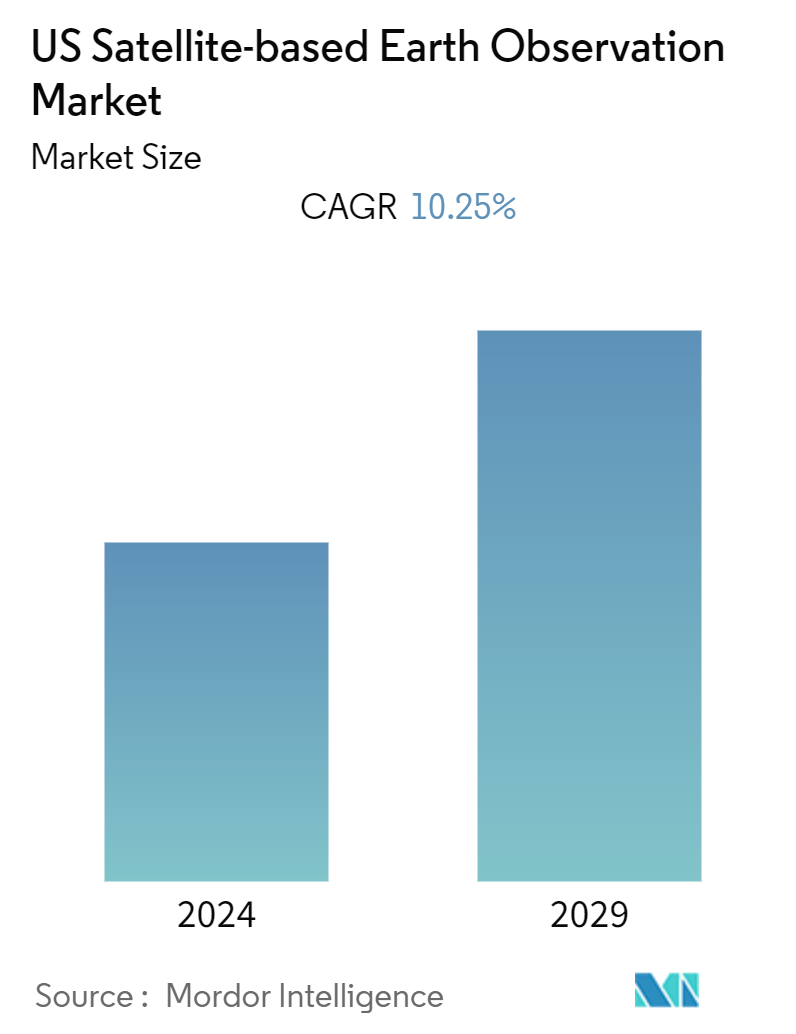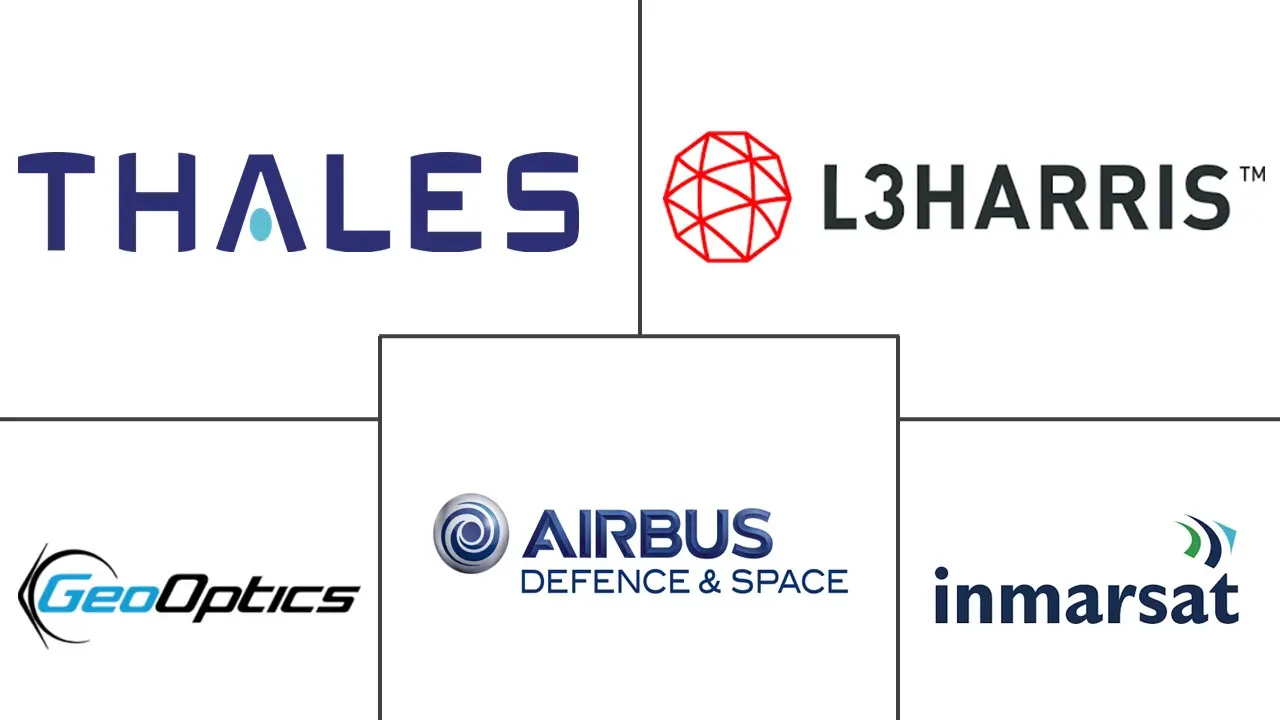Market Size of US Satellite-based Earth Observation Industry

| Study Period | 2019 - 2029 |
| Base Year For Estimation | 2023 |
| Forecast Data Period | 2024 - 2029 |
| Historical Data Period | 2019 - 2022 |
| CAGR (2024 - 2029) | 10.25 % |
| Market Concentration | High |
Major Players
*Disclaimer: Major Players sorted in no particular order |
US Satellite-based Earth Observation Market Analysis
The US Satellite-based Earth Observation Market is expected to register a CAGR of 10.25% during the forecast period.
Satellite-based Earth observation has indeed been experiencing a growing demand in recent years, and the United States has been at the forefront of this industry.
- Earth observation satellites aid in resource management, environmental monitoring and protection, humanitarian aid, and long-term development. Satellites used for environmental monitoring, meteorology, mapping, and other non-military functions are also included. These sensors assess air quality, agricultural health, ice thickness, salinity, and other elements.
- With the growing concern about climate change and its impact on the planet, there is a need for accurate and up-to-date data on various environmental parameters. Satellites provide a valuable tool for monitoring changes in the Earth's climate, including temperature patterns, ice cover, sea level rise, deforestation, and more.
- For instance, in December 2022, the National Aeronautics and Space Administration (NASA) launched a USD 1.2 billion satellite with a high-power radar and other sensitive equipment to better examine the flow of the Earth's water and the effects of climate change. Every three weeks, the satellite will measure water height throughout 70% of the Earth, providing a terabyte of data every day.
- The growth of satellite-based data in agriculture will significantly drive the market. Satellite imagery can assist in monitoring agricultural activities, crop health, soil moisture, and vegetation indices. This information is valuable for farmers, policymakers, and researchers in optimizing crop yields, managing water resources, and ensuring food security.
- For instance, in March 2023, NASA announced the introduction of NASA Acres, a program focused on applying Earth observation data to the most critical agricultural and food security concerns confronting American farmers, ranchers, and agrifood systems. It collaborates with agricultural stakeholders across the spectrum to provide Earth observatory-based data and tools that help improve productivity while safeguarding and repairing land, water, the environment, and human health.
US Satellite-based Earth Observation Industry Segmentation
U.S. Satellite-based earth observation is done with the help of satellites orbiting around the planet to view and identify environmental changes, map making, etc. The satellite-based earth observation technology captures and stores information from satellites relating to the physical, biological, and chemical compositions of the Earth for monitoring, surveillance, and decision-making in various verticals, such as defense and intelligence, infrastructure and engineering, natural resource management, energy and power, and disaster management.
The United States satellite-based earth observation market is segmented by type (earth observation data and value-added services), by satellite orbit (low earth orbit, medium earth orbit, and geostationary orbit), and by end-use(urban development and cultural heritage, agriculture, climate services, energy and raw materials, infrastructure, and other end-users).
The market sizes and forecasts are provided in terms of value (USD) for all the above segments.
| By Type | |
| Earth Observation Data | |
| Value Added Services |
| By Satellite Orbit | |
| Low Earth Orbit | |
| Medium Earth Orbit | |
| Geostationary Orbit |
| By End-User | |
| Urban Development and Cultural Heritage | |
| Agriculture | |
| Climate Services | |
| Energy and Raw Materials | |
| Infrastructure | |
| Other End-Users |
US Satellite-based Earth Observation Market Size Summary
The United States satellite-based Earth observation market is experiencing significant growth, driven by increasing demand for advanced environmental monitoring and data-driven decision-making. This market is characterized by the use of satellites for various non-military applications, including resource management, environmental protection, and humanitarian aid. The growing concerns about climate change and the need for accurate environmental data have propelled the adoption of satellite technology. These satellites play a crucial role in monitoring climate parameters such as temperature patterns, ice cover, and deforestation, providing valuable insights for policymakers and researchers. Additionally, the agricultural sector is benefiting from satellite imagery, which aids in monitoring crop health and optimizing resource management, thereby enhancing food security.
The market is also witnessing substantial advancements in urban development and infrastructure management, with satellite technology offering high-resolution imaging and real-time data for urban planning and transportation management. Earth observation satellites are instrumental in monitoring air quality, land use changes, and urban heat islands, supporting sustainable urban development and environmental conservation efforts. The market is consolidated with major players like Airbus Defense and Space, Maxar Technologies, and Planet Labs Inc., who are actively engaging in partnerships and innovations to enhance their offerings. These companies are leveraging satellite technology to provide geospatial solutions and support critical infrastructure development, ensuring a competitive edge in the evolving market landscape.
US Satellite-based Earth Observation Market Size - Table of Contents
-
1. MARKET INSIGHTS
-
1.1 Market Overview
-
1.2 Industry Attractiveness - Porter's Five Forces Analysis
-
1.2.1 Bargaining Power of Buyers
-
1.2.2 Bargaining Power of Suppliers
-
1.2.3 Threat of New Entrants
-
1.2.4 Threat of Substitutes
-
1.2.5 Intensity of Competitive Rivalry
-
-
1.3 Industry Value Chain Analysis
-
1.4 Assessment of the Impact of COVID-19 on the Market
-
-
2. MARKET SEGMENTATION
-
2.1 By Type
-
2.1.1 Earth Observation Data
-
2.1.2 Value Added Services
-
-
2.2 By Satellite Orbit
-
2.2.1 Low Earth Orbit
-
2.2.2 Medium Earth Orbit
-
2.2.3 Geostationary Orbit
-
-
2.3 By End-User
-
2.3.1 Urban Development and Cultural Heritage
-
2.3.2 Agriculture
-
2.3.3 Climate Services
-
2.3.4 Energy and Raw Materials
-
2.3.5 Infrastructure
-
2.3.6 Other End-Users
-
-
US Satellite-based Earth Observation Market Size FAQs
What is the current US Satellite-based Earth Observation Market size?
The US Satellite-based Earth Observation Market is projected to register a CAGR of 10.25% during the forecast period (2024-2029)
Who are the key players in US Satellite-based Earth Observation Market?
Airbus Defense and Space, Satcom Technologies, Geo Optics Inc., MDA Corporation (Maxar Technologies) and Planet Labs Inc. are the major companies operating in the US Satellite-based Earth Observation Market.

